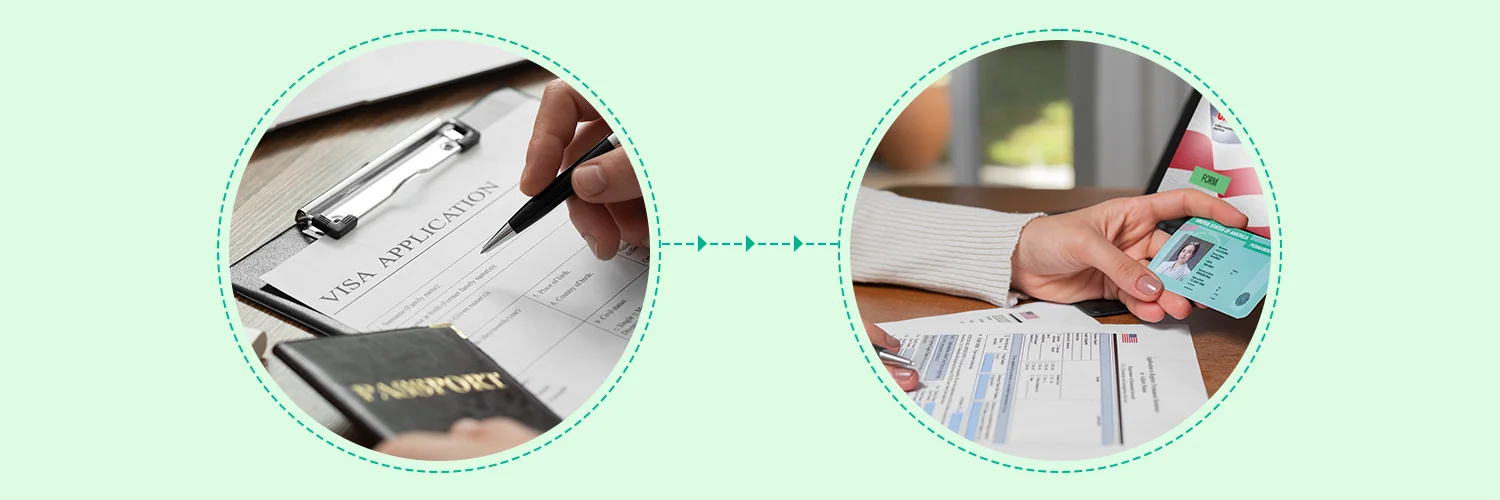
F1 Visa To a Green Card: Become a US Resident as an Indian
The F1 Visa is a student visa that allows international students from India to stay in the US for the duration of an educational course and related practical training. On an F1 visa, you get to enter and exit the US as many times as you need while you’re still a student, as long as you’re actively studying and getting decent grades.
A green card gives you permanent residency, meaning you can stay in the USA indefinitely and are legally allowed to work (and earn) freely. If you want to live in the USA long term without giving up your Indian citizenship, a green card is the best way.
You can change your F1 visa to a green card through employment, special skills, family, marriage, or a diversity lottery programme. However, note that Indians aren’t eligible for the diversity lottery programme in 2024.
Even though the green card process is long and complicated, many people go into their studies intending to transition from an F1 visa to a green card eventually. Let’s look at why people might want to transition from F1 to green cards.
- In case you’re an F1 visa holder, you can work part-time, but only on campus, to earn a little spending money, but there is a hard limit to how much you can earn each year.
- If you want to continue your studies at another institute, change your course, or even take another course, you must update your visa.
- You also don’t benefit from any social welfare programs in the USA. This can all be expensive and tedious.
Before you start wondering how to get PR in the US after study, let’s look at the different paths you can take. In some cases, an H1B visa may be an option, but it’s best to go from an F1 to green card without H1B visa statusin most situations.
Generally, international students in the USA can transition from an F1 visa to green card through employment, marriage, family, diversity, or special skills. The countries eligible for the Diversity Lottery change each year, and India is not on the list of eligible countries for 2024. Make sure to research well about green card eligibility for Indian students.
Understanding the Green Card Process
Following are the paths available to shift your documentation in the US from an F1 visa to green card:
- F1 to green card through employment
- F1 to green card through special skills
- F1 to green card through family
- F1 to green card through marriage
- F1 to green card through diversity lottery
Whatever your path, transitioning from an F1 visa to a green card requires careful planning and preparation. There is a reason why people ask how many years to get PR in the USA for Indian students instead of how many months or weeks. Including the various forms, affidavits, biometrics, medical examinations, and transportation costs, the cheapest possible F1 visa to green card transition will cost you at least USD 1,200 (~ INR 99,000), depending on your category or pathway. Note that other smaller expenses shall accompany this expense.
Also, learn about the average cost of living expenses in the USA..
Whether you’re transitioning from an F1 visa to green card through employment, marriage or family, the steps will mostly be the same. But be sure to cross-check with the official website once again before applying.
Step 1: Depending on whether you are in the US or not, determine whether you are applying for visa adjustment or consular processing.
Step 2: Determine whether you need a sponsorship or petition from someone else for your F1 to green card transition.
Step 3: Submit your form I-485 or other applicable immigration form.
Step 4: Go to your application support centre appointment to submit biometrics and supplemental documentation.
Step 5: If selected, go for your interview.
Step 6: Provide further documentation if needed.
Pathways to a Green Card in the USA for Indians
1. F1 to Green Card through Employment: Employment-Based (EB) Permanent Residency
If you are trying to change your US permit from F1 to green card through employment, you need to be aware of the difference between this and an H1B Visa. The H1B visa is competitive, and there is an upper limit on the total number of H1B visas given out each year. The H1B visa is valid for 3 years (and can be extended by a maximum of 3 years). Some people apply for a green card after their H1B visa is in action, but most fresh graduates go from F1 to green card without H1B visas.
The Employment-Based Green Cards require your employer to petition on your behalf, so you must have a confirmed job or a job offer before you try to go from the F1 visa to green card through employment. It’s also possible to petition for yourself as a business partner, but you must have an investment of at least one million US dollars to do this.
2. Family-Based Green Card Options
If you want to know how to get PR in the USA after your Master’s and cannot use the employment-based route, a family-based option might be for you.
The family sponsorship route needs you to have an immediate family member who is a US citizen. This family member will have to petition for your immigration, and you will have to apply simultaneously. This is called Concurrent filing. It’s important to maintain legal status while you are in the process of transitioning from an F1 visa to green card.
3. Diversity Visa Lottery Program
The Diversity Visa Lottery Program might seem like a dream come true for most people wondering how to get PR in the USA after studies. The US awards a set number of green cards to people from diverse or underrepresented countries. You can apply for it for free and individuals are chosen randomly within national quotas. However, green card eligibility for Indian students since India is not on the list of eligible countries eligible for 2024.
This does not mean it’s impossible to transition from an F1 visa to a green card through the diversity lottery. If your spouse or family member is from an eligible ‘diverse’ country, you can apply in conjunction with the family member.
4. National Interest Waiver (NIW) and Extraordinary Ability (EB-1A) Green Cards
The National Interest Waiver program (NIW) offers a path to a green card for people with skills or expertise that are considered necessary for the country’s well-being. For instance, if the US is in shortage of electrical engineers, and you have that expertise, you may be able to apply for a green card without specific employment.
The Extraordinary Ability Green Cards (EB-1A) work in a similar way but are focused on your special skills. This is most applicable to people who are highly acclaimed experts in their field, geniuses, etc. In this immigration category, getting a green card for PhDs is slightly more plausible, but you will still transition your F1 visa to green card through employment.
5. F1 to Green Card Through Marriage
Transitioning from an F1 visa to green card through marriage is a little safer through marriage— it will not likely be rejected if everything is in order, but it will still take a long time. You need to find a judge willing to officiate the marriage, get married, and receive the marriage certificate.
There is a rigorous process to prove that it’s a bona fide marriage to a citizen or green card holder. If you try to convert your F1 visa to a green card holding status through marriage, and it turns out that you attempted to commit marriage fraud, there are severe repercussions such as jail time, a fine, deportation, or all three.
In a Nutshell
The green card process is long and complex, and it is necessary to maintain legal status throughout. Some ways to transition from an F1 visa to a green card are:
- Through employment
- Through family
- Through the diversity visa lottery programme
- Through special skills - National Interest Waiver (NIW) and Extraordinary Ability (EB-1A)
- Through Marriage
Adjustment of Status vs Consular Processing
Irrespective of your path to progressing from an F1 visa to green card status, your steps, associated costs, and forms will differ slightly depending on whether you are applying through an Adjustment of Status or Consular Processing. Adjustment of Status is applicable if you are in the US at the time of application under a valid visa. You don’t need to leave the country for this. If you are not in the US or are anticipating needing to leave, you could opt for Consular Processing, where you would process your application through your local embassy.
Dealing with Visa Retrogression
When trying to convert your F1 visa to green card status, you need to be aware that there will be interruptions and delays. The most frustrating of all these is probably visa retrogression. Visa retrogression occurs when visa demand surpasses the annual limit, causing delays in visa issuance, particularly in the U.S. immigration system. Eligible individuals may face waiting periods until more visas become available in the next fiscal year.
This can be super disheartening and inconvenient, so make sure that you plan for it. Anything you can do to stay in legal status will help you, such as applying for a different visa type till the green card is processed. Unless you are trying to get a green card for PhDs, you could try to study another course or apply as a tourist if you can stay without working. You may need to leave the US for some time and apply through consular processing.
Learn more about the types of US visas you can apply for while waiting for your green card application to be processed!
Key Takeaways
There are numerous paths to convert your status as holding an F1 visa to green card status.
For Indians, the approaches are related to employment, family, marriage, or special skills.
There are extenuating circumstances related to being a refugee, asylum seeker, or victim of abuse or crime, but these are independent of the process of converting an F1 visa to a green card.
The green card application process is lengthy and nuanced, so plan for it beforehand. As with most things in life, this process will go a lot smoother if you have support from the right people.
Despite all the challenges and complexities, transitioning from an F1 visa to a green card is doable.
Stay patient and organised, you should not be afraid to apply for a permanent residency in the US if it will help you achieve your dreams and goals.







